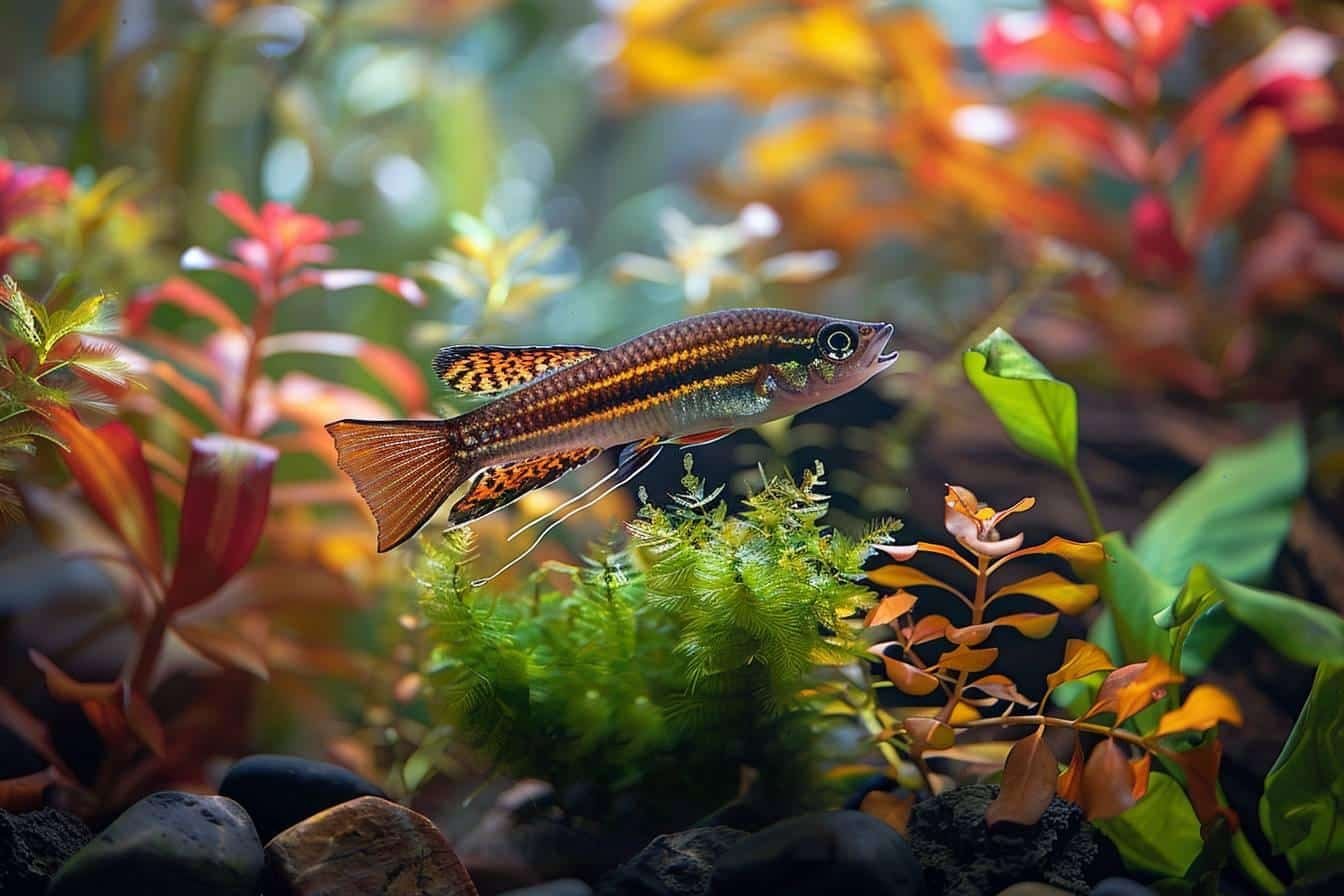Le pangio kuhlii fishalso known as the kuhli loche or snake loche, is a fascinating little fish native to South-East Asia. As a pet shop floor manager, I've had the opportunity to observe these intriguing creatures at close quarters and advise many aquarists on how to keep them. Let me introduce you to this unusual fish and give you some tips on how to care for it in your aquarium.
Characteristics and origin of pangio kuhlii
The pangio kuhlii belongs to the Cobitidae family and is distinguished by its unique appearance. Its elongated, slender body, measuring between 8 and 12 cm when fully grown, has earned it the nickname "snake locust". Its orange or yellow colour, dotted with dark spots, gives it a truly charming leopard-like appearance.
Native to the fresh waters of Southeast Asia, it is found mainly in Indonesia, Malaysia and Thailand. In its natural habitat, this fish prefers calm mountain rivers and streams. I was lucky enough to visit some of these regions during a trip and was amazed by the diversity of the local aquatic fauna.
Here are a few physical characteristics of the Pangio kuhlii:
- 3 pairs of barbels around the mouth
- An erectile thorn under the eyes
- A protective membrane over the eyes
These adaptations enable it to orientate and protect itself in its natural environment. In addition, the pangio kuhlii has an auxiliary respiratory organ that allows it to breathe atmospheric air, an interesting feature that bears witness to its evolution.
Aquarium maintenance and care
Although the Pangio kuhlii is a robust fish that is easy to maintain, it is important to respect certain conditions to ensure its well-being in the aquarium. Here are my recommendations based on my professional experience:
Water parameters and volume
To house a group of Pangios kuhlii comfortably, you'll need an aquarium of at least 120-150 litres. These fish appreciate the following parameters:
| Parameter | Recommended value |
|---|---|
| Temperature | 22-30°C (ideally 24-28°C) |
| pH | 5,5-7,2 |
| Hardness | 1-13 GH |
A monthly renewal of 20-30% of water volume is recommended to maintain good water quality. I've noticed that these fish are particularly sensitive to changes in atmospheric pressure, a detail to bear in mind when maintaining the aquarium.
Decor and living together
The Pangio kuhlii is a shy, nocturnal fish, so it's essential to provide plenty of hiding places. Use roots, rocks and plants to create a reassuring environment. Opt for a substrate of fine sand to avoid injuries when they are searching the bottom.
As far as living together is concerned, these fish are peaceful and enjoy life in a group. You should keep a minimum of 5-6 fish, ideally 8-10, to ensure that they reach their full potential. Avoid combining them with aggressive fish or Cichlids. They can live harmoniously with aquarium shrimpsThis will add diversity to your aquatic ecosystem.
But beware: these clever little creatures may try to escape through the filter. An open aquarium is therefore not recommended. I was once surprised to find a pangio kuhlii hidden in the filter compartment during a cleaning!

Feeding and reproduction of the Pangio kuhlii
As an omnivore, the Pangio kuhlii is not difficult to feed. In the wild, it feeds mainly on small invertebrates and organic debris that it finds while digging through the substrate.
Diet
In the aquarium, you can offer them :
- Bloodworms (their favourite food)
- Food for groundfish
- Flakes or granules that sink to the bottom
- Frozen foods such as artemia or daphnia
Don't hesitate to vary their diet to ensure a good nutritional intake. I've noticed that these fish are particularly active during their nocturnal meals - a real sight to behold with a torch!
Captive breeding
Pangio kuhlii are notoriously difficult to reproduce in aquariums, and little is known about their breeding methods. In the wild, these fish generally reproduce during the rainy season, when the water level rises and the temperature drops slightly.
If you want to give it a go, here are a few tips:
- Maintain a group of at least 8-10 individuals to increase the chances of pairs forming
- Simulate the rainy season by increasing the water changes and lowering the temperature slightly.
- Offer a rich and varied diet to condition breeding stock
- Use a fine substrate and plants with fine leaves for laying eggs.
Be patient, because even in the best conditions, reproduction remains a challenge. In my 15-year career, I have personally witnessed only a few successful reproductions of Pangios kuhlii in aquariums.
Pangio kuhlii: an interesting fish to discover
With a life expectancy of up to 15-16 years, the pangio kuhlii is a long-lasting companion for your aquarium. Its affordable price, usually between €2 and €5, makes it an attractive option for both novice and experienced aquarists.
As a keen aquarist, I can only recommend that you include these little loaches in your aquarium. Their gregarious behaviour and serpentine movements will bring life and originality to your installation. Don't forget to observe them at night, when they are most active and you can really appreciate their unique personality.
Whether you're a novice or a seasoned aquarist, the Pangio kuhlii will win you over with its charm and peaceful character. So, are you ready to dive into the interesting world of these little snake fish?
